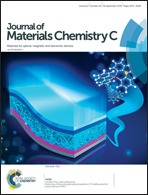Deep-blue emitting poly[spiro(dibenzoazasiline-10′,9-silafluorene)] for power-efficient PLEDs
Abstract
Starting from poly(2,7-spirosilabifluorene) (PSSiBF), deep-blue emitting poly(5′-(5′′-hexylundecyl)-2,7-dibenzoazasiline-10′,9-silafluorene) (PSDBASiF) has been newly demonstrated for power-efficient PLEDs, where dibenzoazasiline instead of dibenzosilole is spiro-linked to the poly(dibenzosilole) backbone. Owing to the electron-donating nature of dibenzoazasiline, the HOMO and LUMO energy levels are found to be upshifted from −6.10/−2.40 eV of PSSiBF to −5.61/−2.16 eV of PSDBASiF. Simultaneously, hypsochromic absorption and emission maxima are observed for PSDBASiF, while its film photoluminescence quantum yield (PLQY) remains close to that of PSSiBF (0.84). PLEDs based on PSDBASiF realize a record-high power efficiency of 1.16 lm W−1 together with a peak EQE of 2.74% and CIE coordinates of (0.16, 0.06). Compared with PSSiBF (<0.2 lm W−1), an about 6-fold improvement is achieved for the power efficiency of PSDBASiF without sacrificing the EQE and color purity. The result clearly indicates that the incorporation of spiro-linked dibenzoazasiline into poly(dibenzosilole) is a promising strategy to develop power-efficient silicon-containing polymers with deep-blue emission.
![Graphical abstract: Deep-blue emitting poly[spiro(dibenzoazasiline-10′,9-silafluorene)] for power-efficient PLEDs](/en/Image/Get?imageInfo.ImageType=GA&imageInfo.ImageIdentifier.ManuscriptID=C8TC03074J&imageInfo.ImageIdentifier.Year=2018)


 Please wait while we load your content...
Please wait while we load your content...